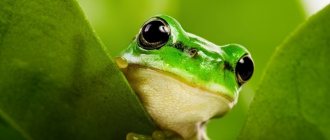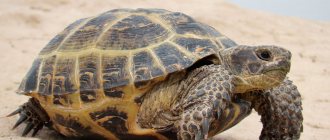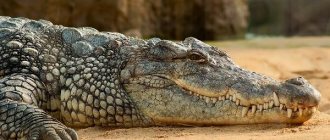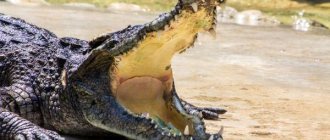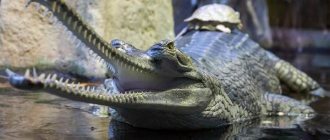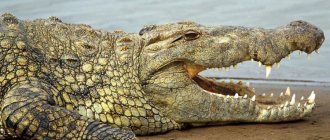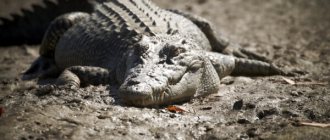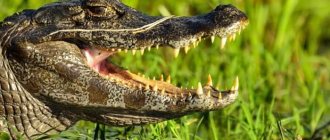Crocodile is a special type of reptile whose lifestyle is semi-aquatic. In appearance, the crocodile resembles smooth stones, so people should be careful near bodies of water and vegetation, as the animal can quickly attack.
Thanks to their coloring, crocodiles are able to camouflage themselves perfectly in nature.
Crocodiles belong to the class of archosaurs; an adult can reach 3 meters in length, and some giants can reach 7 meters. Crocodiles weigh from 250-500 kg, with one head weighing 200 kg; as a rule, males are much larger than females.
Characteristics and description
Crocodiles spend most of their lives in water. You can see them on land only in the morning or evening hours, when they crawl ashore for a short time to bask in the sun. This way of life raises a completely natural question: is the crocodile an amphibian or a reptile?
Crocodiles are the only order that represents the subclass of archosaurs in the modern fauna. These ancient reptiles appeared on the planet about 200 million years ago.
The first crocodiles were land reptiles, but during the process of evolution they gradually returned to the water. This is confirmed by the respiratory organs, keratinized dry skin, five-fingered limbs, a four-chambered heart, and eggs covered with a hard, waterproof shell. A change in the shape of the muzzle with a displacement of the nostrils to the upper part, the appearance of membranes between the toes, a decrease in the length of the legs - these and other characteristics inherent in amphibians were formed in the process of adaptation to life in water. In this regard, in biology, crocodiles are classified as secondary aquatic reptiles.
All animals belonging to the class of reptiles are cold-blooded. Crocodiles differ from other reptiles in their ability to thermoregulate. Due to the structure of the circulatory system, large size and the ability to accumulate heat in the horny plates covering the skin, the body temperature of a crocodile changes by only 1-2 degrees. At the same time, it should not be confused with warm-blooded representatives of the fauna, in which temperature is maintained due to the intensity of metabolic processes.
Human economic activity and the uncontrolled extermination of reptiles, including for the production of valuable crocodile skin, have led to a significant reduction in their numbers. Currently, Indian, Siamese, Orinoco and Cuban crocodiles, the Gangetic gharial, and the Chinese alligator are included in the International Red Book with the status of “endangered species.”
What does it look like
All species of crocodiles, alligators and caimans have common external characteristics:
- the body is massive, elongated, with a long tail, the upper part is covered with comb-like horny plates;
- the head is large with elongated jaws, the eyes have a vertical pupil, the nostrils are located at the end of the muzzle;
- the paws are short, with sharp claws and small membranes between the toes.
The color of a crocodile's skin depends on its habitat. As a rule, the color is dominated by gray, brown, brown, and dark green shades. The underparts are usually lighter in color. Sometimes albinos are born, but such individuals have practically no chance of surviving in natural conditions.
What is the difference between a crocodile and an alligator and a caiman?
All representatives of the order have a common ancestor, but living conditions and food consumed led to the appearance of some external differences. To determine the type of predator, you should carefully examine it:
- in crocodiles the snout is pointed and noticeably narrows, while in alligators and caimans it is wide along the entire length and rounded;
- crocodiles have longer hind legs;
- alligators have more teeth, but they are smaller and not as sharp as crocodiles;
- When the jaws are closed, the crocodile's longer teeth 4 and 5 protrude, while in alligators and caimans they are not visible.
A distinctive feature is also their body size: alligators and caimans are noticeably smaller than real crocodiles.
How much do they weigh
Crocodiles, unlike most other animals, continue to grow and gain weight even after puberty. The weight and size of adults depend on the species.
| Variety | Weight, kg | Body length, m |
| Saltwater crocodile | 2000 | 7 |
| Mager | 500 | 5 |
| Mississippi alligator | 400 | 4,5 |
| Australian crocodile | 100 | 3 |
| Cuban crocodile | 70 | 2,5 |
| Crocodile caiman | 60 | 2 |
What temperature does a reptile's body reach?
Everyone knows that males and females of the crocodile family are cold-blooded animals, and their temperature readings are inconsistent. But their dinosaur-like physique gives them the ability to tense their muscles and in this way warm up their blood. Therefore, the body temperature may be several degrees higher than the environment. Moreover, this indicator also increases due to the absorption of solar energy and the so-called “behavioral thermoregulation,” that is, the absorption of heat from other surfaces. This happens in this way: on the back of the animal there are scutes, and under them there are osteoderms, which form a shell and accumulate heat throughout the day. They are also a heat transfer regulator. Also, the color of the reptiles may change. Thus, the body temperature of a predator can even reach 35 degrees, but it varies and depends on many factors.
If a predator gets very hot from solar energy, it climbs into a body of water to cool down. When cooling occurs, the animal crawls to the surface to bask. In large males, the fluctuations are most often one degree in summer and one and a half in winter. If the male is small in size, then they can boast fluctuations of up to five degrees and above.
The peculiarity of predators to maintain constant temperature values is called inertial homeothermy (an inaccurate concept - warm-bloodedness). This feature can also manifest itself in the fact that a constant temperature can be maintained not due to metabolism, but due to the size of the individual, large mass and habits that are dictated by the physiology of the creature - basking in the sun, cooling in a pond, and so on.
The temperature balance is also normalized by the fact that individuals always keep their mouths open when in the sun. After all, part of the heat is lost when liquid evaporates from the mucous membrane of the animal’s oral cavity.
When the temperature increases, reptiles heat up slowly, when they decrease, they cool down quite slowly, and since crocodiles have a high heat capacity, temperature differences are simply smoothed out.
The internal structure of representatives of the crocodile family also plays a role in thermoregulation, namely the presence of a four-chambered heart, as well as the ability of hemoglobin to carry large amounts of oxygen. This makes it possible for adult individuals to maintain metabolism and heat at the same high level. It also allows you to quickly adapt to changes in the environment.
If compared with true homeothermy, which is characteristic of mammals and birds, then inertial is that there is no need for nutrition at a sufficiently high activity. That is, those who are truly warm-blooded simply depend on food, since it is part of the source of metabolism. As for representatives of the crocodile family, they are free from this dependence. However, there is also a disadvantage of such homeothermy - reptiles have a different kind of dependence - they depend on climate. The climate should be fairly stable, without severe cold or warm temperatures. This is the reason why representatives of crocodiles can only be found in the tropics. Their northernmost point in the wild is Florida. In this state they live next to alligators.
Species of crocodiles
The detachment unites three large families:
- real crocodiles;
- alligators;
- gharials.
Crocodiles are represented by 6 modern genera and 25 species, among which the following are of greatest interest:
- Nile crocodile. Distributed on the African continent. The color is light brown with noticeable dark stripes. It is distinguished by its ferocity and aggressiveness, capable of attacking animals significantly larger than itself.
- Mager (swamp crocodile). The habitat is limited to the territory of India. The color combines dark green and olive colors. It feeds mainly on fish; there are known cases of attacks on people.
- Sharp-snouted crocodile. Lives in fresh water bodies of Central and South America. The skin is colored brown. The diet is based on fish, birds and turtles.
- New Guinea crocodile . Endemic to Indonesia and New Guinea. The skin is gray in color with transverse dark gray stripes. It is exclusively nocturnal and hunts birds, amphibians and crustaceans.
- African dwarf crocodile. The maximum body length of the reptile does not exceed 1.5 m. Protection from larger predators is provided by hard, ossified plates covering the upper part of the body. Due to its habitat in remote regions, very little information has been collected about this species.
- Blunt crocodile. Distributed in the west-central part of the African continent. The body length can reach 2 m. It is nocturnal and rests in burrows most of the day.
- Gharial . Distributed in southern Asia. The main characteristic feature is a very narrow muzzle, adapted for catching fish. Completely safe for people.
Sun
Infrared radiation (that is, heat transfer without direct contact with the source) from the sun has a huge effect on reptiles. For temperate latitudes, the following behavior of reptiles is very typical: they crawl out to bask in the sun or heat from the effects of its rays on stones. Thanks to this adaptive apparatus, the body temperature of a snake on a sunny day can be 10-15 degrees higher than the ground surface.
It is noteworthy that to the south or in the mountains, sand and stones heated by the sun can not only heat, but also kill the animal. Therefore, reptiles use different adaptation mechanisms to avoid overheating. Lizards have adapted to walk on a hot surface, raising their tails, raising their bodies as much as possible, walking “on their toes,” and throwing their paws high as they step.
When it gets hot, snakes are more active at night. For example, the viper is one of the most dangerous snakes in the viper family; in the spring, having emerged from hibernation, it leads a diurnal lifestyle, hunts and lays eggs, and by summer it becomes less active and prefers to stay awake at night. Great activity in the spring is associated with the hunger of the animal after hibernation, which drives the snake to hunt.
How many years do crocodiles live in the wild?
Most members of the order are true long-livers. The average life expectancy of a crocodile is 50-60 years. Some individuals live up to 70 and even 100 years.
At the same time, not all cubs born can reach such a respectable age. Most of the eggs laid by females and the young hatched from them become food for birds, turtles, monitor lizards, anacondas, and some mammals. A decrease in the mortality rate is observed only among crocodiles that have reached adolescence.
Individuals that have gained a mass of several kilograms have every chance of surviving to old age due to the absence of natural enemies, with the exception of larger relatives.
Reptile skin is covered with scales (or bony plates)
Reptile scales, which develop from the epidermis (the outermost layer of the skin), are small, hard plates of keratin. The shells of turtles and the osteoderms of crocodiles are similar in appearance and function to scales, but are bony structures that form in the deeper layer of the skin - the dermis. Scales and bony plates provide reptiles with physical protection and also prevent moisture loss; in many species, the shape and color of these structures play a role in territorial activity and courtship during the breeding season. Keep in mind that while all reptiles have scales, this is not a characteristic unique to reptiles (it is also found in butterflies, birds, lizards, and fish).
How many teeth does a crocodile have?
The number of teeth depends on the species. For example, a swamp crocodile has only 60 of them, and an alligator has 76-80.
The structure of crocodile teeth is as follows: they all have a conical shape, with the lower part located in the recess of the jaw bone, each fang is pointed at the top and consists of a strong shell that is hollow inside. As the outer part of the tooth wears down, a new fang grows inside it. The regularity of replacement depends on the feeding habits of the animals.
Crocodiles are the only reptiles that have a functional separation of teeth, and their placement in the mouth is such that opposite the largest teeth of one jaw are the smallest on the opposite.
Most reptiles lay eggs
Reptiles are amniotic animals, which means that the eggs laid by females contain a germinal membrane within which the embryo develops. Most reptiles are oviparous, in which the eggs have a hard shell, but a few lizards are viviparous, where live embryos develop inside the female.
You may be under the impression that only mammals are viviparous, but this is not true: not only do some reptiles give birth to live young, but even some species of fish do.
Most reptiles differ from mammals in that they lack a placenta, which allows developing embryos to be nourished inside the uterus.
How to hunt
Reptiles are one of the few species of animals that can hunt in groups, coordinating their actions. They usually wait in ambush for their prey and pounce on it, making a sudden and precise jump. During a hunt, several crocodiles are divided into groups, one of which drives the prey, and the second waits for it and attacks.
Reptiles are quite inventive: for example, during the nesting period of birds, they specially place small branches and other building material on their faces, thus luring prey.
Since the structure of the mouth does not allow chewing food, crocodiles cut the carcass into pieces and swallow them whole. To tear off a piece, they grab the meat, squeeze their jaws tightly and, as it were, twist it, rotating around its axis.
What do they eat
The diet of crocodiles depends on the species and age. Most species feed exclusively on meat. They attack zebras, antelopes, buffalos and even young elephants. Mammalian predators often become victims of crocodiles.
Reptiles can eat birds and fish
For small-sized juveniles, frogs, insects, and small fish become food. To improve the digestion of food, crocodiles swallow stones.
CHAMELEON
Inertial homeothermy: how important is it for reptiles?
It should be noted that inertial homeothermy is very important for predatory reptiles, and therefore determines most of their main life processes:
- if the mark is below 20 degrees, then the male becomes inactive and lethargic, since he simply cannot reach the required temperature value on his own (if the temperature value decreases for a long time, the animal dies);
- a temperature above 38 degrees is also disastrous for reptiles, since they do not have a developed self-cooling system at all;
- individuals begin the morning by simply crawling out of the pond to warm up their blood under the influence of the sun’s heat;
- during drought (as well as in the absence of food), some of the species of the crocodile family can hibernate - hibernation is quite long and can even reach the spirit of years.
It is worth noting that the value of the ambient temperature even affects the gender of future cubs, but we will talk about this a little below. It is also important that when keeping predatory reptiles in captivity, the temperature is regulated using special heaters.
How do they reproduce?
Crocodiles reach sexual maturity at the age of 8-10 years. In many species, reproduction does not depend on the season and can occur throughout the year.
Mating of crocodiles usually occurs in water. Both males and females mate with multiple partners. The mating season is accompanied by fights between males, noisy splashes, growls and howls. After its completion, the females look for or prepare a place for future laying. They can lay up to several dozen eggs at a time. The female covers the clutch with earth or grass and remains nearby until the cubs appear.
The duration of embryo development and their sex depend on air temperature. Since the babies cannot get out of the eggs on their own, they squeak loudly, calling their mother, who digs up the clutch and breaks the shell. The length of newborn crocodiles is 20-30 cm.
The female carries the hatched babies into the river: she picks them up several in her mouth and releases them into the water. The cubs are cared for until they are two years old.
VARAN
Class Amphibians
Amphibians, or this class is also called amphibians, are very different from all other vertebrates. The very first difference is that they have two stages of development. The first is that at a young age, amphibians look like fish. They also have a tail and gills, and they are all born in water. The second stage in development is the emergence of amphibians from the water and the restructuring of the entire organism for life both in water and on land: lungs develop, the tail disappears. The most obvious example in this case is a frog.
Given such differences, why does the question arise: is a crocodile a reptile or an amphibian? The fact is that the crocodile lives in water, has lungs and can also be considered an amphibian to some extent. But it does not have stages of rebirth, like amphibians. Crocodiles are born fully formed and not in water, but on land. And only after a while they seem to return to the aquatic environment. Now let's look at why a crocodile is a reptile.
Where does the crocodile live?
The reptile's habitat extends to the tropics and subtropics. Representatives of the order can be found in Africa, North and South America, the southern regions of Asia and on the islands located in the western Pacific Ocean.
Habitat
Crocodiles are found primarily in fresh water bodies, although some species can live in slightly brackish water: off sea coasts near river deltas, in bays and bays. They usually choose shallow sections of rivers with calm currents. The American alligator prefers to live in swamps.
Typically, predators live in the same territory all their lives. The exception is the saltwater crocodile, which often changes its habitat. Thus, reptiles living in Oceania periodically move from island to island, covering significant distances of several hundred kilometers.
AXOLOTL
Reptiles are cold-blooded animals
The body temperature of cold-blooded animals is determined by the temperature of their environment; this contrasts with warm-blooded animals, whose body temperature is maintained within a small, constant range largely independent of external conditions. Because they are cold-blooded or ectothermic, reptiles must bask in the sun to increase their core body temperature, which in turn allows for increased activity levels. When they overheat, reptiles retreat into the shade to cool down to a safer temperature, and at night many species are virtually motionless.
If the ambient temperature drops significantly, the reptiles fall into a state of torpor, as happened in Florida, when iguanas fell from the trees from the cold.
Sources
- https://fb.ru/article/252833/krokodil—presmyikayuscheesya-ili-zemnovodnoe-shodstva-i-otlichiya
- https://fermbiz.ru/raznye/temperatura-tela-krokodila/
- https://fb.ru/article/346196/zavisimost-temperaturyi-tela-zmei-ot-okrujayuschey-sredyi
- https://givotniymir.ru/krokodil-zhivotnoe-obraz-zhizni-i-sreda-obitaniya-krokodila/
- https://www.syl.ru/article/373155/kto-takoy-krokodil—zemnovodnoe-ili-presmyikayuscheesya
- https://www.what-this.ru/nature/animals/
- https://natworld.info/zhivotnye/kratkaja-harakteristika-klassa-presmykajushhihsja
[collapse]
Interesting facts about crocodiles
- The reptile is considered one of the most dangerous predators on the planet. A crocodile attack on a person usually ends tragically. Most often, people become victims of Nile and saltwater crocodiles, and black caiman.
- When eating prey, crocodiles secrete tears - the secretion of glands located under the eyes. In this unusual way, the animal removes excess salt from the body. Because of this feature of the reptile, the phraseological phrase “shedding crocodile tears” has appeared in many languages of the world. The expression means fake regret to one's victim.
- In one meal, a crocodile can eat an amount of meat equal to a quarter of its own weight.
- The largest crocodile of all modern species is the saltwater or combed crocodile. The length of adult males reaches 7 m.
- The maximum speed of a crocodile on land is 15-17 km/h. In water, he is able to move almost twice as fast.
